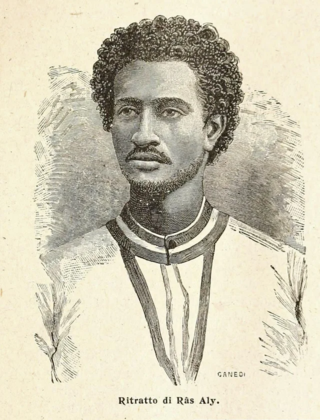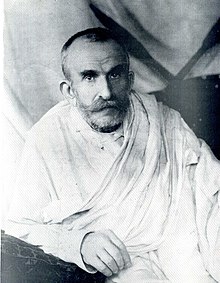
Antoine Thomson d'Abbadie d'Arrast was an Irish-born French explorer, geographer, ethnologist, linguist and astronomer notable for his travels in Ethiopia during the first half of the 19th century. He was the older brother of Arnaud-Michel d'Abbadie, with whom he travelled.

Tewodros II was Emperor of Ethiopia from 1855 until his death in 1868. His rule is often placed as the beginning of modern Ethiopia and brought an end to the decentralized Zemene Mesafint.
Yohannes III was Emperor of Ethiopia intermittently between 1840 and 1851, and a member of Solomonic dynasty. He was the son of Tekle Giyorgis. He was largely a figurehead, with real power in the hands of the Enderase or Regent, Ras Ali II a princeling of the Yejju Dynasty. Ras Ali's mother was the Empress Menen Liben Amede.
The French surname Abbadie or d'Abbadie, meaning "(of the) abbey", may refer to:
Yonas was Emperor of Ethiopia from 18 August 1797 to 4 January 1798, and a member of Solomonic dynasty. He was the son of Letezum, and the grandson of the Emperor Fasilides.
Sahle Dengel was Emperor of Ethiopia intermittently between 1832 and 11 February 1855, towards the end of the Zemene Mesafint. He was largely a figurehead, with real power in the hands of Ras Ali II of Yejju.
Yimam of Yejju was a Ras of Begemder and Enderase (regent) of the Emperor of Ethiopia. He was the son of Gugsa of Yejju.

Ali II of Yejju was Ras of Begemder and the de facto ruler of the Ethiopian Empire. He was a member of a powerful Welo dynasty known as the Yejju, which ruled much of the Ethiopian Empire during the Zemene Mesafint.

Sabagadis Woldu was a governor of Tigray Province of the Ethiopian Empire from 1822 to 1831. Sabagadis gained some notoriety in the first decade of the 19th century for rebelling a number of times against his overlord, Ras Wolde Selassie. But just before the death of Wolde Selassie it seems that he made up with his master and became one of his loyal lieutenants. Following Wolde Selassie's death in 1816, he defied the authority of Wolde Selassie's son, and became the most powerful warlord in Tigray. Making Adigrat his capital, he ruled Tigray and the coastal plains of Eritrea by 1818. His rule also extended to the Eritrean highlands.

Arrast-Larrebieu is a commune in the Pyrénées-Atlantiques department in the Nouvelle-Aquitaine region of south-western France.
The Battle of Debre Tabor was a conflict during the Zemene Mesafint in 1842 initiated by Dejazmach Wube Haile Maryam to overthrow Ras Ali II as Regent of the Emperor of Ethiopia and gain control of Ethiopia. This confused battle was won by Ras Ali, but at a steep price, and this victory failed to cement his position as the most powerful nobleman of his time.
Dembecha is a town in northwestern Ethiopia 349 km north of Addis Ababa. Located in the Mirab Gojjam Zone of the Amhara Region, this town has a latitude and longitude of 10°33′N37°29′E with an elevation of 2083 meters above sea level. It is one of three towns in Dembecha woreda.

Semien Province was a historical province of northwest Ethiopia. According to Manoel De Almeida Semien was bordered on the north-east and north by Tigray and Tselemt, on the east and south by Abergele, and on the west by Wegera. Alexander Murray include Wag as part of Semien.

The Château d'Abbadia, also Château d'Abbadie, is a neogothic château situated in Hendaye, Pyrénées-Atlantiques, France. Built by Eugène Viollet-le-Duc and Edmond Duthoit, both patronized by the explorer Antoine d'Abbadie, between 1864 and 1879, it is classified as a historic monument and "Maison des Illustres". The scientific collections, archives and furniture are all authentic and make up a considerable cultural heritage of the 19th century.

Wube Haile Maryam of Semien,, also called by his title Dejazmach Wube, Webé; his name is also given in European sources as ‘‘Ubie’’, was one of the major figures of 19th century Ethiopia, during the closing decades of the Zemene Mesafint a period of regional lords vying for power, prestige and territory amid a weakened authority of the emperors.
The Bursuuk or also written as Barsuk, Barsuq and Barsoub is a clan belonging to Madahweyne sub-clan of the Dir clan family and are not related to the Musa Ali section of the Arap who adopted their name. They largely live in Ethiopia, in the Somali Region, especially around the ancient city of Harar and between the city and Jigjiga.
The battle of Konzula was a military conflict which took place during the period of the "Zemene Mesafint" between Dejazmach Goshu, prince of Gojjam, and his son Birru against the sons of Dejazmach Kenfu.
Goshu Zewde of Gojjam, also known by his horse name Abba Kanno, was a prominent governor of Damot, Metcha, and Ybaba during the first half of the 19th century. While his son Birru Goshu governed most of Gojjam, Goshu’s influence extended widely, solidifying his reputation as a formidable leader. As a member of the ruling dynasty of Gojjam, he was one of the significant lords in the last decades of the Zemene Mesafint. Respected by princes, church leaders, and farmers alike, Goshu was admired for his noble lineage and his admirable character. His influence and dedication were further recognized when he was granted the title of Dejazmach in 1825 and elevated to Ras by Emperor Sahle Dengel in 1848.
Dakkar, also known as Dakar, or Deker, was a historical Muslim town located in present-day eastern Ethiopia. It served as the first capital of the Adal Sultanate after its founding in the early 15th century by Sabr ad-Din III.
Dejazmach Birru Goshu (1814-1869) of Gojjam was a significant Ethiopian noble who held considerable sway over the political landscape of Ethiopia during the latter period of the Zemene Mesafint, a time of intense regional competition among ruling dynasties. According to the British diplomat Walter Plowden, Birru Goshu was "the most remarkable man in Abyssinia" before the rise of Tewodros II.













